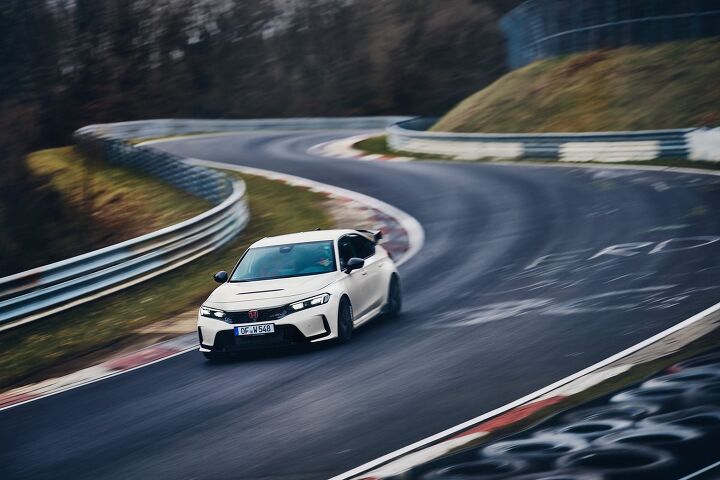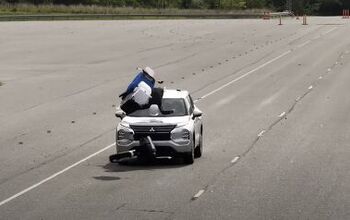2023 Honda Civic Type R Takes Nürburgring Lap Record

When it comes to performance vehicles sporting front-wheel drive, the Honda Civic Type R is usually the model everyone looks to as the benchmark, and the eleventh generation seems to be no different. The manufacturer has announced that the 2023 Honda Civic Type R is now the fastest front-drive production car to ever lap Nürburgring Nordschleife.
While the Nürburgring has become notorious for "spoiling" road cars by encouraging the manufacturer to make them overly specialized, the track also allows the kind of durability testing you won’t find anywhere else. Furthermore, having built the performance vehicle that holds the lap record is the kind of marketing money just can’t buy. Love or hate the track, there’s a sense of prestige that comes along with having dominated it and Honda knows this better than most.
From Honda:
Under the concept of 'Ultimate SPORT 2.0,' we developed the all-new Civic Type R with the spirit of 'going beyond our past achievements' and strived for the ultimate FWD sports car by refining the 'essential value' and 'emotional appeal' unique only to our Type R models.
Since the start of sales in Japan in September 2022, we have received numerous customer feedback from all around the world filled with amazement and joy, far exceeding our expectations. However, we still had one more mission to fulfill, which was to claim the title as the world's fastest FWD car with a record Nürburgring lap time.
Six years after the lap record was set by the previous-generation Civic Type R (FK8), we reached this new dimension as a result of all of the passions we poured in and all the advancements we made for this Type R model. Finally, our wish to share this title with all Type R fans all around the world came true.
Honda reported that the Type R ran the thirteen-mile course in 7:44.881. It was enough to best the previous record holder (the 2019 Renault Mégane R.S. Trophy-R) time by over half a second.
The car was aided by a set of Michelin Pilot Sport Cup 2 tires, which are about as aggressive as you can get for a warm-weather tire intended for road use. Honda will allow you to add them to the Type R for just under $2,000 and they’re basically mandatory if you’re thinking about trying to set a lap record at the Nürburgring.
With that in mind, perhaps we should be offering praise to Michelin, too — as the former front-drive record holder was wearing the Bridgestone S007s originally designed for the Ferrari F12berlinetta.
Honda’s hottest Civic certainly seems to live up to its deserved hype. But we can’t say whether it would have been able to best the course wearing different rubber. Your author has never believed the old axiom that ‘shoes make the man.’ But it’s undeniable that tires sometimes help to make the car.
For those interested, Honda has provided footage of the complete lap. We imagine it'll stand for a year or two unless someone surprises us with a better tire or a front-drive vehicle more monstrous than the Civic Type R.
[Images: Honda]
Become a TTAC insider. Get the latest news, features, TTAC takes, and everything else that gets to the truth about cars first by subscribing to our newsletter.

A staunch consumer advocate tracking industry trends and regulation. Before joining TTAC, Matt spent a decade working for marketing and research firms based in NYC. Clients included several of the world’s largest automakers, global tire brands, and aftermarket part suppliers. Dissatisfied with the corporate world and resentful of having to wear suits everyday, he pivoted to writing about cars. Since then, that man has become an ardent supporter of the right-to-repair movement, been interviewed on the auto industry by national radio broadcasts, driven more rental cars than anyone ever should, participated in amateur rallying events, and received the requisite minimum training as sanctioned by the SCCA. Handy with a wrench, Matt grew up surrounded by Detroit auto workers and managed to get a pizza delivery job before he was legally eligible. He later found himself driving box trucks through Manhattan, guaranteeing future sympathy for actual truckers. He continues to conduct research pertaining to the automotive sector as an independent contractor and has since moved back to his native Michigan, closer to where the cars are born. A contrarian, Matt claims to prefer understeer — stating that front and all-wheel drive vehicles cater best to his driving style.
More by Matt Posky
Latest Car Reviews
Read moreLatest Product Reviews
Read moreRecent Comments
- W Conrad I'm not afraid of them, but they aren't needed for everyone or everywhere. Long haul and highway driving sure, but in the city, nope.
- Jalop1991 In a manner similar to PHEV being the correct answer, I declare RPVs to be the correct answer here.We're doing it with certain aircraft; why not with cars on the ground, using hardware and tools like Telsa's "FSD" or GM's "SuperCruise" as the base?Take the local Uber driver out of the car, and put him in a professional centralized environment from where he drives me around. The system and the individual car can have awareness as well as gates, but he's responsible for the driving.Put the tech into my car, and let me buy it as needed. I need someone else to drive me home; hit the button and voila, I've hired a driver for the moment. I don't want to drive 11 hours to my vacation spot; hire the remote pilot for that. When I get there, I have my car and he's still at his normal location, piloting cars for other people.The system would allow for driver rest period, like what's required for truckers, so I might end up with multiple people driving me to the coast. I don't care. And they don't have to be physically with me, therefore they can be way cheaper.Charge taxi-type per-mile rates. For long drives, offer per-trip rates. Offer subscriptions, including miles/hours. Whatever.(And for grins, dress the remote pilots all as Johnnie.)Start this out with big rigs. Take the trucker away from the long haul driving, and let him be there for emergencies and the short haul parts of the trip.And in a manner similar to PHEVs being discredited, I fully expect to be razzed for this brilliant idea (not unlike how Alan Kay wasn't recognized until many many years later for his Dynabook vision).
- B-BodyBuick84 Not afraid of AV's as I highly doubt they will ever be %100 viable for our roads. Stop-and-go downtown city or rush hour highway traffic? I can see that, but otherwise there's simply too many variables. Bad weather conditions, faded road lines or markings, reflective surfaces with glare, etc. There's also the issue of cultural norms. About a decade ago there was actually an online test called 'The Morality Machine' one could do online where you were in control of an AV and choose what action to take when a crash was inevitable. I think something like 2.5 million people across the world participated? For example, do you hit and most likely kill the elderly couple strolling across the crosswalk or crash the vehicle into a cement barrier and almost certainly cause the death of the vehicle occupants? What if it's a parent and child? In N. America 98% of people choose to hit the elderly couple and save themselves while in Asia, the exact opposite happened where 98% choose to hit the parent and child. Why? Cultural differences. Asia puts a lot of emphasis on respecting their elderly while N. America has a culture of 'save/ protect the children'. Are these AV's going to respect that culture? Is a VW Jetta or Buick Envision AV going to have different programming depending on whether it's sold in Canada or Taiwan? how's that going to effect legislation and legal battles when a crash inevitibly does happen? These are the true barriers to mass AV adoption, and in the 10 years since that test came out, there has been zero answers or progress on this matter. So no, I'm not afraid of AV's simply because with the exception of a few specific situations, most avenues are going to prove to be a dead-end for automakers.
- Mike Bradley Autonomous cars were developed in Silicon Valley. For new products there, the standard business plan is to put a barely-functioning product on the market right away and wait for the early-adopter customers to find the flaws. That's exactly what's happened. Detroit's plan is pretty much the opposite, but Detroit isn't developing this product. That's why dealers, for instance, haven't been trained in the cars.
- Dartman https://apnews.com/article/artificial-intelligence-fighter-jets-air-force-6a1100c96a73ca9b7f41cbd6a2753fdaAutonomous/Ai is here now. The question is implementation and acceptance.



































Comments
Join the conversation
I'm sure Honda did more than just add high performance rubber to their publicity stunt car.
The Nürburgring is a beautiful place with lots of interesting vehicles and people. What's the point of trying to get it all over with as fast as you can? Slow down and enjoy the day, for goodness sake! /s
Seriously, it's good that the car manufacturers compete to improve the characteristics of their vehicles. Now if only we could design a Nürburgring-type competition for quality interiors, outward visibility and the durability of drivetrains and electronics.